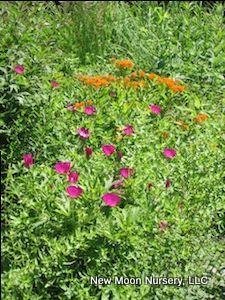Printed at http://www.newmoonnursery.com/index.cfm/
Callirhoe involucrata
Wine cups
Native to North America
FIRST IMPRESSIONS: Callirhoe involucrata is a mat forming perennial with attractive lobed leaves. In late spring and summer, plants are covered with a mantle of lovely magenta cup shaped blossoms. The flowers have white throats and look similar to tiny hibiscus blossoms. Plants thrives in sunny sites with dry or average soil.
HABITAT & HARDINESS: Callirhoe involucrata is native to the Central United States and parts of the Eastern and Southwestern United States. The most populated part of the range extends from North Dakota through the Midwest, down to Arizona and east to Arkansas and Texas.
Plants are indigenous to dry meadows, prairies, roadsides, open woods, rocky banks and open fields with low sparse vegetation.
Hardy from USDA Zones 4-9.
PLANT DESCRIPTION: Callirhoe involucrata is an attractive spreading groundcover. Plants are anchored by a substantial taproot that can be up to 4” in diameter. Procumbent stems emerge from the root and trail along the ground for up to 3’.
Foliage is pubescent and rounded with 5-7 deeply cut finger-like lobes. The leaves have an outline similar to a stylized snowflake or the tropical scented geranium. In short, foliage is unique and striking.
Plants are clothed with masses of cup or chalice shaped blooms in late spring and early summer. The unusual flower color could be described as maroon, wine, hot pink or magenta. The blossoms are 1”-2” across with a distinctive white throat and are frequented by native bees and butterflies.
Plants grow 6” to 1 foot tall with 1-3’ spread.
CULTURAL & MAINTENANCE NEEDS: Callirhoe involucrata grows best in full sun or part sun in well drained to dry soil. Plants tolerate drought, poor infertile soils and dry rocky soils.
If conditions are too wet, plant may suffer from rust and be consumed by slugs. Foliage is eaten by rodents, deer and livestock.
Excess shade and competition from neighboring plants can lead to decline and death.
LANDSCAPE USES: This is a good choice for a Dry Sunny Bank, Groundcover or in the front section of a Perennial Border. Plants are lovely when trailing over low garden walls and are useful as Accents, Butterfly Nectar Plants, Butterfly Host Plants or as part of a Grouping or Mass Planting. Callirhoe involucrata has Showy Blooms, Attractive Foliage and can be used in Cottage Gardens, Low Maintenance Plantings, Prairies, Dry Meadows, Rock Gardens, Water-wise Landscapes, Roadsides and Wildlife Gardens.
COMPANION & UNDERSTUDY PLANTS: Try pairing with Asclepias tuberosa, Amsonia hubrichtii, Baptisia tinctoria, Blephilia ciliata, Eragrostis spectabilis, Phlox pilosa, Liatris microcephala, Nepeta ‘Walker’s Low’, Schizachyrium scoparium, or Sporobolis heterolepis.
Phlox subulata ‘Emerald Pink’ has similar growth habit, flower color and cultural needs and can be substituted if needed.
TRIVIA: The myriad of common names attests to the uniqueness of Callirhoe involucrata flowers. Plants are sometimes called wine cups due to their winey color and goblet shape or Purple poppy-mallow due to their resemblance to poppies and their mallow cousins. The name Buffalo rose is due to the plant’s Midwestern range and flower shape similar to an heirloom single rose.
Callirhoe involucrata belongs to the Mallow or Hibiscus Family.
Plants host caterpillars of Gray Hairstreak Butterfly and Checkered Skipper.
Height:
6-12 inSpread:
1-3 ftSpacing:
2-3 ftUSDA Hardiness Zone:
3-9Bloom Color:
Purple RedCallirhoe involucrata Characteristics
Attracts Wildlife
- Pollinators
- Butterflies
Attributes
- Favorite
- East-Coast Native
- Drought Tolerant
- Rock Garden
- Clay Soil
- Naturalizing
- Long Blooming
- Ground Cover
Exposure
- Full Sun to Partial Shade
Flowering Months
- August
- July
- June
- September
Foliage Color
- Green
Soil Moisture Preference
- Dry
Interesting Notes:
For more information on this plant, visit the USDA PLANTS Database: http://plants.usda.gov/java/profile?symbol=CAIN2

